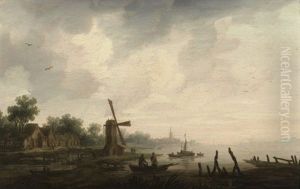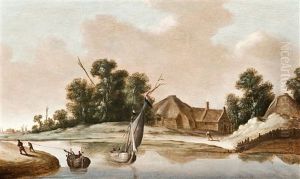Pieter Nolpe Paintings
Pieter Nolpe was a Dutch Golden Age painter, printmaker, and draftsman, primarily known for his etchings and engravings. Born in the early 17th century, around 1613 or 1614, Nolpe's early life and training are not well documented, which is not uncommon for artists of that period. However, it is believed that he was active in Amsterdam, which was a burgeoning center of art and commerce at the time.
Nolpe's artistic career unfolded during a period in Dutch history known as the Dutch Golden Age, a time when Dutch trade, science, military, and art were among the most acclaimed in the world. Amsterdam, in particular, was a hub for artists and intellectuals, and the city's thriving art market provided ample opportunities for artists like Nolpe.
Though Nolpe's paintings are not as widely recognized today, his etchings and engravings have garnered more attention. He produced works that depicted various subjects, including landscapes, portraits, and scenes from daily life. His style was typical of the Dutch Golden Age, characterized by a keen attention to detail and a strong emphasis on realism.
Among his notable works are a series of prints depicting the siege of 's-Hertogenbosch in 1629, an event during the Eighty Years' War when the Dutch Republic was fighting for independence from Spanish rule. These prints were important historical documents as well as works of art, capturing the drama and complexity of the siege.
Nolpe's death is believed to have occurred in either 1652 or 1653. Although his work may not have achieved the same level of fame as some of his contemporaries, such as Rembrandt or Vermeer, Nolpe contributed to the rich tapestry of Dutch Golden Age art. His prints continue to be of interest to collectors and historians, providing insight into the cultural and historical context of the time.




















